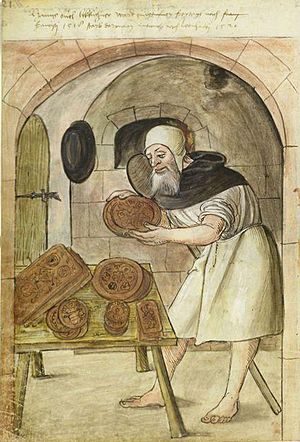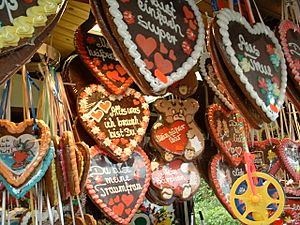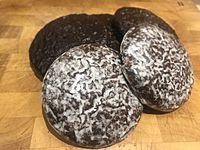- This page was last modified on 17 October 2025, at 10:18. Suggest an edit.
Lebkuchen facts for kids
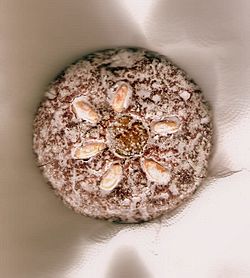
|
|
| Alternative names | Pfefferkuchen |
|---|---|
| Type | Cake |
| Place of origin | Germany |
| Region or state | Franconia |
| Main ingredients | Honey, spices (aniseed, coriander, cloves, ginger, cardamom, allspice), nuts (almonds, hazelnuts, and walnuts), candied fruit |
Lebkuchen (which sounds like layp-koo-khen) is a special German cookie or cake. It's also called Honigkuchen (honey cake) or Pfefferkuchen (pepper cake). These treats are sweetened with honey and are a big part of Germany's Christmas traditions. They are quite similar to gingerbread.
What's in a Name?
The first part of the word Lebkuchen (Leb-) has a few possible meanings. Some people think it comes from an old Latin word for "flat bread." Others believe it comes from a German word meaning "loaf" or "very sweet."
Another idea is that it comes from Leb-Honig. This was a thick, solid kind of honey taken from a beehive. This honey was mostly used for baking.
Many people also connect the name to the German words for "life" (Leben) or "body" (Leib). The second part, Kuchen, simply means 'cake'.
The History of Lebkuchen
The idea of honey cakes is very old. It goes back to the Egyptians, Greeks, and Romans. They thought honey was a gift from their gods. They also believed it had special healing powers. Sometimes, people even wore honey cakes as good luck charms in battles. They hoped it would protect them from bad spirits.
Bakers found that dough sweetened with honey would naturally bubble and get better if stored in a cool place. This process is called fermentation. Because of this, Lebkuchen dough was often started in November. Then, it was baked in December, after it had fermented for several weeks.
Monks in Franconia, Germany, are thought to have invented Lebkuchen in the 13th century. Records show Lebkuchen bakers in Ulm as early as 1296. By 1395, they were also in Nürnberg (Nuremberg). Today, Nuremberg is famous for its Nürnberger Lebkuchen.
A story from Nuremberg says that in 1487, Emperor Friedrich III visited the city. He invited all the children and gave almost four thousand of them special Lebkuchen. These cookies had his picture printed on them.
Historically, Lebkuchen was also known as "honey cake" or "pepper cake." This was because of the different ingredients used. These cookies are usually quite large. They can be about 11.5 centimeters (4.5 inches) wide if they are round. In Nuremberg, only members of the baker's guild were allowed to bake these holiday cookies.
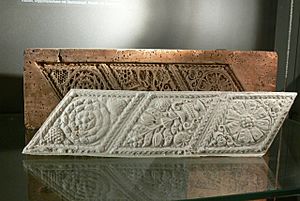
This mold was used for marzipan or Lebkuchen in the 17th or 18th century.
Since 1808, a special kind of Nuremberg Lebkuchen has been made without flour. It's called Elisenlebkuchen. We don't know for sure who Elise was. She might have been a baker's daughter or a noblewoman. Her name is now linked to some of the best Lebkuchen.
Since 1996, Nürnberger Lebkuchen has a special status. It's a "protected designation of origin." This means it can only be made within the city limits of Nuremberg.
Different Kinds of Lebkuchen
Lebkuchen can taste spicy or sweet. They come in many shapes, but round is the most common. The main ingredients are usually honey and spices. These spices often include aniseed, coriander, cloves, ginger, cardamom, and allspice. They also contain nuts like almonds, hazelnuts, and walnuts, or candied fruit.
In Germany, different types of Lebkuchen are named by the kinds and amounts of nuts they contain. Special ingredients like "Salt of Hartshorn" and "potash" are often used to help the dough rise.
The Lebkuchen dough is usually placed on a thin wafer base. This base is called an Oblate. Monks came up with this idea. They used ingredients similar to communion wafers to stop the dough from sticking. Often, Lebkuchen are covered with dark chocolate or a thin sugar glaze. Some are left plain.
Most Lebkuchen are soft. But there's a harder type used to make Lebkuchenherzen (Lebkuchen hearts). These hearts usually have messages written on them with icing. You can find them at many German fairs and Christmas fairs. They are also sold as souvenirs at the Oktoberfest. The messages on them can be sweet, funny, or even a bit cheeky!
Another fun form is the "witch's house" (Hexenhäusl). This was made popular by the fairy tale of Hansel and Gretel. The German version of the gingerbread man is the Honigkuchenpferd (honey cake horse).
The Nuremberg type of "Lebkuchen" is also known as "Elisenlebkuchen." It must have at least 25 percent nuts and less than 10 percent wheat flour. The best bakeries in Nuremberg use almost 40% nuts! Sometimes, Lebkuchen comes in fancy decorated tins or boxes. These often become special collector's items.
Gallery
-
Different shapes of Lebkuchen on sale at the Christkindlesmarkt, Nuremberg
See also
 In Spanish: Lebkuchen para niños
In Spanish: Lebkuchen para niños

